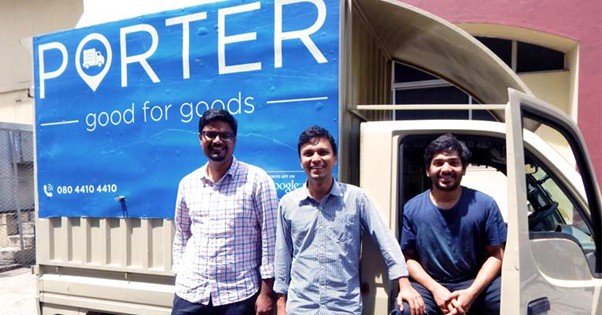The Billion-Dollar Delivery: The Porter Story (2025)


Chapter 1: The Last Mile Problem (2014-2023)
In the beginning, logistics in India’s metro cities wasn’t just fragmented; it was a chaos engine running on intuition, high fuel costs, and sheer hope. For a small business owner needing a tempo to shift $5,000 worth of goods across Bangalore, the process involved three phone calls, 45 minutes of negotiation, and absolutely zero guarantee of arrival time.
This was the problem that Pranav Goel, Uttam Digga, and Vikas Choudhary set out to solve in 2014 with Porter. Their vision was simple: bring the Uber model to intra-city goods movement. They weren’t building a trucking company; they were building an intelligence layer that could match an atom (the load) with a molecule (the truck or two-wheeler) in real-time.
The early years were a relentless, grinding test of unit economics. Porter’s innovation wasn’t just the app, but the asset-light model—partnering with existing truck owners and bike riders, digitizing their schedules, and optimizing their return trips, effectively turning a single-trip loss into a multi-trip profit. They prioritized MSMEs (Micro, Small, and Medium Enterprises), the backbone of the Indian economy, who paid immediately and provided recurring, predictable demand. This laser focus on small-scale, high-frequency B2B transactions created a fundamentally resilient cash flow structure, unlike peers chasing slow-paying large enterprises or high-burn consumer-only models.
By 2023, the scale was impressive: 20+ cities, hundreds of thousands of registered drivers, and annual operating revenue soaring past $300 million. But the market had changed. Quick commerce giants were moving into last-mile logistics, and while their focus was tiny parcels, the sheer volume threatened to dilute the driver base. Porter needed to make a decisive move to solidify its leadership and prove it wasn’t just a great logistics company, but a genuine tech platform.
Chapter 2: The Quantum Leap (Project Velocity, 2024)
In late 2023, CEO Uttam Digga greenlit “Project Velocity,” a 12-month strategy designed to achieve profitability and a $1 billion valuation by mid-2025. The core of Velocity had three pillars:
- Hyper-Precision Matching: Overhaul the proprietary algorithm, ‘Route-IQ 2.0.’ This wasn’t just about finding the nearest truck; it was about predicting demand based on weather, local holidays, industrial production cycles, and even construction permits, guaranteeing an average fulfillment time under 30 minutes in Tier-1 cities.
- Electric Vehicle (EV) Transition: Commit capital to driver financing for electric two- and three-wheelers. This was crucial for hitting environmental targets and, more importantly, drastically reducing the driver’s per-kilometer operational cost, boosting their earnings by 15% and reinforcing loyalty.
- The MSME Gateway: Launch a dedicated enterprise solution allowing MSMEs to manage their entire supply chain (inter-city parcel, warehousing, and intra-city haulage) through a single Porter dashboard, turning them from simple delivery customers into holistic logistics partners.
The year 2024 was defined by execution ruthlessness. The team narrowed its focus, slashing non-core marketing expenses and doubling down on driver onboarding and training. The results were visible in the financials. For the fiscal year ending March 2024, Porter managed to cut its net losses by 45%, even as revenue climbed by a staggering 56%. The unit economics had finally flipped decisively to positive.
Chapter 3: The Series F and the Valuation Moment (May 2025)
By the end of Q1 2025, the data was undeniable: Porter was profitable on an operational level across its major markets and had built a moat around its core business that was technologically impenetrable. They had redefined what it meant to move goods in India. No longer was it a transaction; it was a frictionless utility.
The atmosphere in the Bengaluru headquarters was tense but electric. The Series F round, initially scoped at $150 million, grew to $200 million, attracting the attention of global investment heavyweights like Kedaara Capital and Wellington Management. They weren’t just buying growth; they were buying proven financial discipline in a notoriously cash-hungry sector.
On May 8, 2025, the news broke. Porter had closed its Series F, entering the coveted unicorn club with a valuation between $1.1 and $1.2 billion. It was India’s second unicorn of the year, a moment that heralded not just a financial victory, but a cultural shift.
The press release was issued, celebrating the technological platform that empowered over 300,000 gig workers and served over 3 million customers monthly. The founders, often humble and execution-focused, finally allowed themselves a moment of reflection.
“We didn’t set out to be a billion-dollar company,” Uttam Digga said during the celebratory huddle. “We set out to ensure that the small store owner, the vendor, and the driver were treated with transparency and efficiency. The valuation is simply the market recognizing the sheer economic value of taking a broken system and making it intelligent. We are not just delivering parcels; we are delivering economic empowerment, one perfectly routed trip at a time.”
The Series F capital was immediately earmarked for the next great scaling challenge: expanding into 20 new Tier 2 and Tier 3 cities, and investing heavily in the infrastructure to support over 1 million gig workers, solidifying Porter’s position as the ubiquitous, technology-first logistics layer of India. The billion-dollar delivery was complete, but the true journey of scaling had only just begun.
Disclaimer: We do not claim ownership of any data, images, or thoughts shared on this article. Content is based on publicly referenceable data and provided for informational purposes only and the. Any views expressed belong to their respective owners. We strive for accuracy but disclaim liability for reliance on the content.